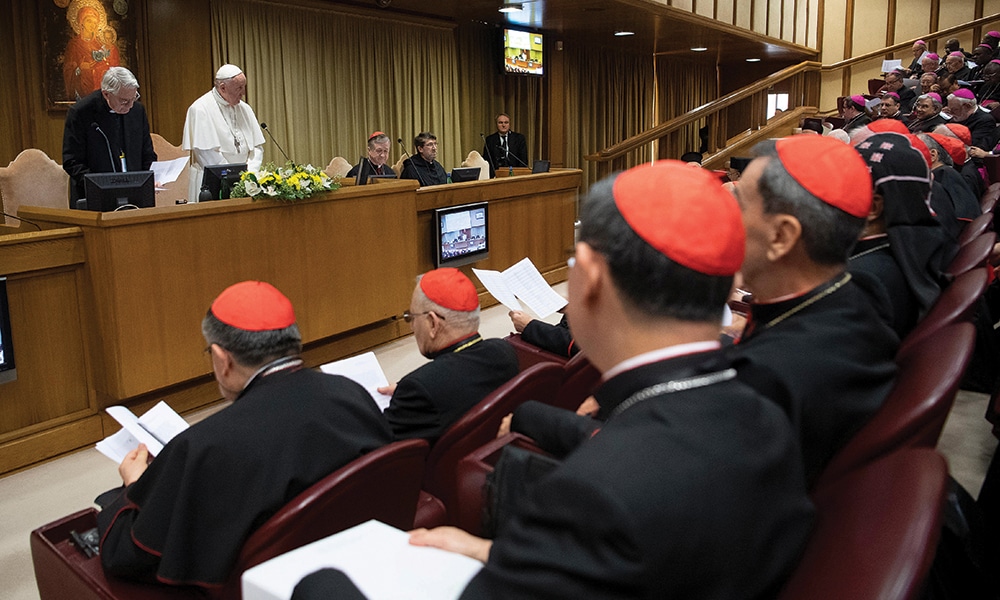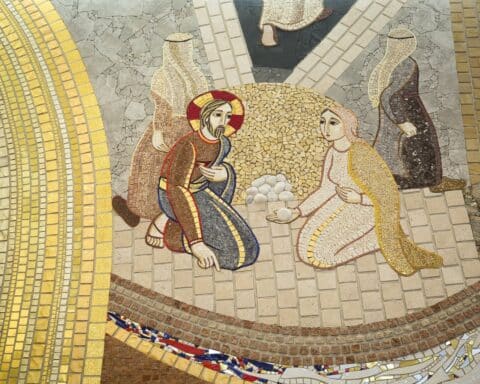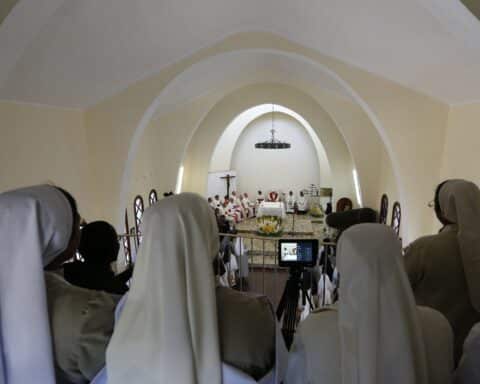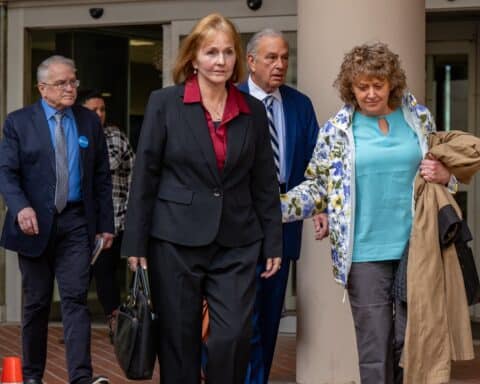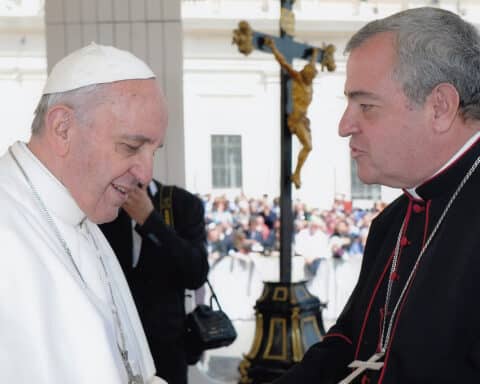Now that Pope Francis’ sexual abuse summit has ended — a convocation of more than 100 heads of episcopal conferences throughout the world — many Catholics rightly wonder what comes next in addressing the crisis of clergy sexual abuse. As for the Church in the United States, our attention necessarily turns once again to our shepherds: What will the bishops do now?
As a national episcopal conference, and in the wake of last year’s summer of scandal, the bishops had convened in Baltimore in November, ready to discuss and approve a series of new policies that would constitute a substantive, though only initial, set of responses not only to the ongoing abuse crisis, but to their own crisis of credibility and failed leadership.
Progress toward approving and implementing those initiatives — including a code of conduct for bishops, the institution of a new and primarily lay-led commission to investigate and report on allegations of sexual misconduct by bishops — was abruptly halted by the Holy See just as the November gathering of bishops was getting underway. It remains to be seen, now that the February Church-wide sexual abuse summit has concluded, whether Pope Francis will allow the American bishops to proceed in the development and adoption of these and other proposals at their upcoming June meeting.
For the past several months, no doubt most bishops have felt overwhelmed at the demands that they take action. As lay anger over years of episcopal malfeasance, passivity, doctrinal ambiguity, disingenuousness, deception and cover-up of abuse was reaching a boiling point last fall, most bishops seemed to remain dumbfounded as to what exactly they should do, whether individually or as a body.
At this juncture, however, bishops urgently need to get over the sense of bewilderment and start taking steps — one after another — to do what they can within their dioceses to address this crisis. Individual bishops must stop reacting and start acting.
But bishop-managers will no longer do. Only bishop-shepherds can adequately address this crisis, and we need them to step forward and lead. Here are some thoughts on what they can do immediately to address this crisis and contribute — overnight — to help the Church toward healing.
First, bishop-shepherds will recognize that Theodore McCarrick’s dismissal from the clerical state was only one crucial step toward a fuller response on the part of the Holy See. They will continue to press for the Holy See to authorize an independent investigation of McCarrick’s rise to prominence to uncover once and for all those who knew what, and when. And they will demand the public repentance — and as the cases may warrant, the resignations — of prelates who, aware of the rumors surrounding him, nevertheless promoted McCarrick or remained silent.
Genuine shepherds of Christ’s flock will continue to teach boldly and convincingly the truth about human sexuality, and they will take effective steps to address the problem of sexually active priests in their midst. They will acknowledge the fundamental link between the sexual abuse of minors and the sexual activity of priests with adults. They will grasp that episcopal silence and passivity with regard to the latter only fosters the climate of concealment and secrecy that makes the former abuse possible. They will advocate for amendments to the Church’s Code of Canon Law to codify a new series of penalties for priests and bishops involved in sexual relationships of any kind. But they will also take action within their own dioceses to identify priests who are sexually active with adults, particularly those who put vulnerable men and women at risk of sexual exploitation, abuse or assault.
In their own dioceses, bishops can in fact take two immediate steps that over time could contribute to curtailing the sexual activity of clerics. First, bishops can expand the role of their diocesan review boards — already tasked with advising the bishop on cases of clerical sexual abuse of minors — to include purview over allegations of sexual misconduct of clerics with adults.
Additionally, they could expand the role of the diocesan promoter of justice. In canon law, the “promoter of justice” is someone akin to a public prosecutor. Typically a chancery canon lawyer, and often a cleric, the promoter of justice’s role is generally a limited one, requiring his involvement, for example, in the occasional canonical penal trial.
In an expanded role, the promoter of justice ideally would be a lay canon lawyer, and the job description would be expanded to resemble that of an ombudsman or civil district attorney. This individual could be provided with a staff and given a broad range of action and oversight. Although the promoter of justice would report directly to the bishop, in order to assure a higher standard of transparency and accountability, the promoter could include the diocesan review board in his or her chain of reporting and even be assisted by that board in the investigation of allegations.
Finally, bishop-shepherds will continue to keep victims of clergy sexual abuse in the forefront of their concerns. In early June 2018, I was blessed to speak to participants at the 13th annual Child and Youth Protection Catholic Leadership Conference, a national gathering of more than 200 diocesan safe-environment coordinators and sexual abuse assistance coordinators. Teresa Kettelkamp, former executive director of the U.S. Conference of Catholic Bishops’ Secretariat for Child and Youth Protection and current member of the Pontifical Commission for the Protection of Minors, worried that some bishops are wavering in their commitment to accompany abuse victims.
“No one — not a vicar general or much less a diocesan attorney — can replace the power of a bishop meeting personally with a victim,” she reminded us. “As we get further and further away from the shock of 2002, I fear that this is becoming less and less the practice. The Church has worked too hard for too long for some bishops to step back now.”
Bishop-shepherds will understand that it is not up to them to determine when they have “done enough” for survivors of abuse. And looking ahead to what almost certainly will be several more years of frequent painful headlines generated by ongoing investigations by U.S. attorneys general and grand juries of multiple dioceses across the country, a bishop’s nearness to those most broken by the crisis — the victims — and his readiness to meet with them will be more crucial than ever to the Church’s eventual healing.
Beyond the bishops, of course, there remains the indispensable role of lay Catholics: to pray, to speak out, to continue to demand answers, transparency and accountability on all levels; to challenge — publicly if necessary — the inaction and malfeasance of bishop-managers, and to support and sustain the courageous (if, at times, imperfect) efforts of bishop-shepherds, and the witness, ministry and fidelity of the Church’s many, many faithful priests who need the laity’s intentional concern, presence, friendship, care and support more than ever.
Father Thomas Berg is vice rector and professor of moral theology at St. Joseph’s Seminary in Yonkers, New York. He is author of “Hurting in the Church: A Way Forward for Wounded Catholics” (OSV, $15.95).

